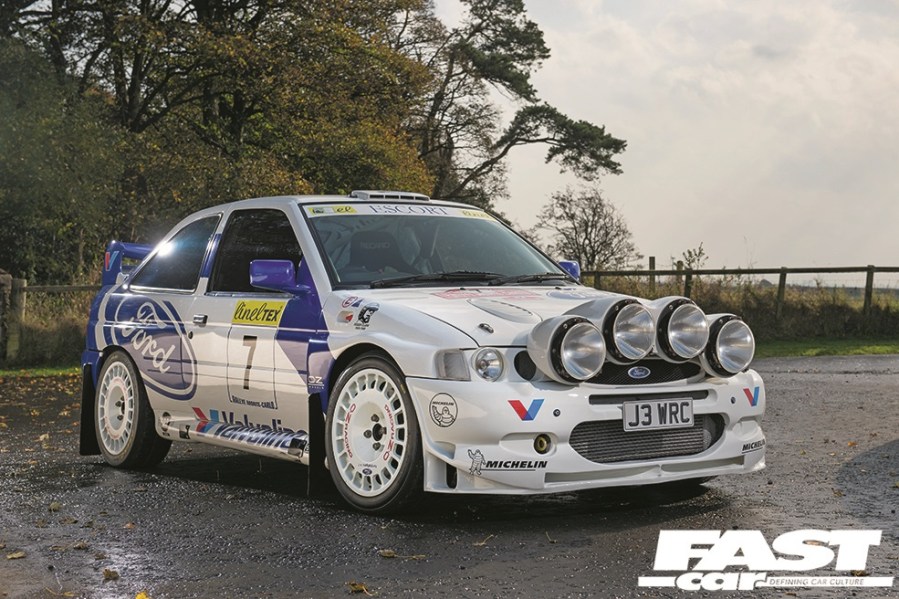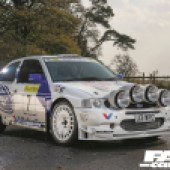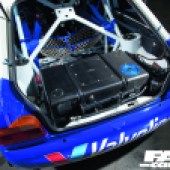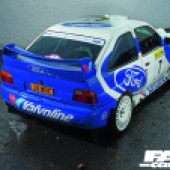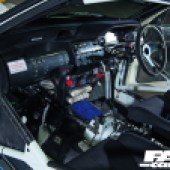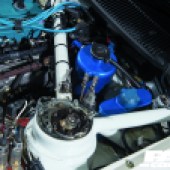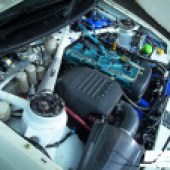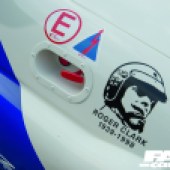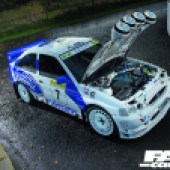The Focus was still in development when the new WRC rules came in for 1997, but Ford didn’t want to miss out on the rally action. So, as a robust stopgap, they reworked their Group A Escort into this, the WRC Ford Escort Cosworth…
Your taut knuckles shine white as you grip the chunky Alcantara rim of the dished blue steering wheel. Waiting. Anticipating. Sharp, shallow breaths start to fog the inside of the visor, so you reach up to open it a crack, before engaging the starter and enjoying the frantic WUH-wuh-WUH-wuh-WUH-wuh before the hot YB catches and settles immediately into a busy idle, like a demijohn full of enraged wasps. The crackle of the exhaust reverberates around the car, creating its own sonic bubble that irresistibly draws the gaze of every rally-jacketed enthusiast in the vicinity; it echoes from the support vans and marshal stations as you flex your right ankle to test the throttle travel, a volley of pops and bangs your just reward.
The sight of the marshal leaning over the bonnet with her clipboard seems incongruous in an age of satellite tracking and instant connectivity, but as she drops her hand to wave you onward it fires an immediate synaptic crossbow bolt across your frontal lobes and down into your solar plexus; there’s no mental decision-making, merely simple instinct that buries your toes into the bulkhead. The Escort rockets forward with improbable thrust, your co-pilot already calmly but insistently outlining the angle details of the approaching corners. Gravel clatters and pings from the undercarriage, while wind rushes malevolently over that swooping rear spoiler. You’re out-of-body now, immutable trust in the car’s capabilities urging you onward into improbable corner speeds, drift angles and apex-hunting. It’s just you, your co-pilot, this heart-fluttering car, and a world of noise.
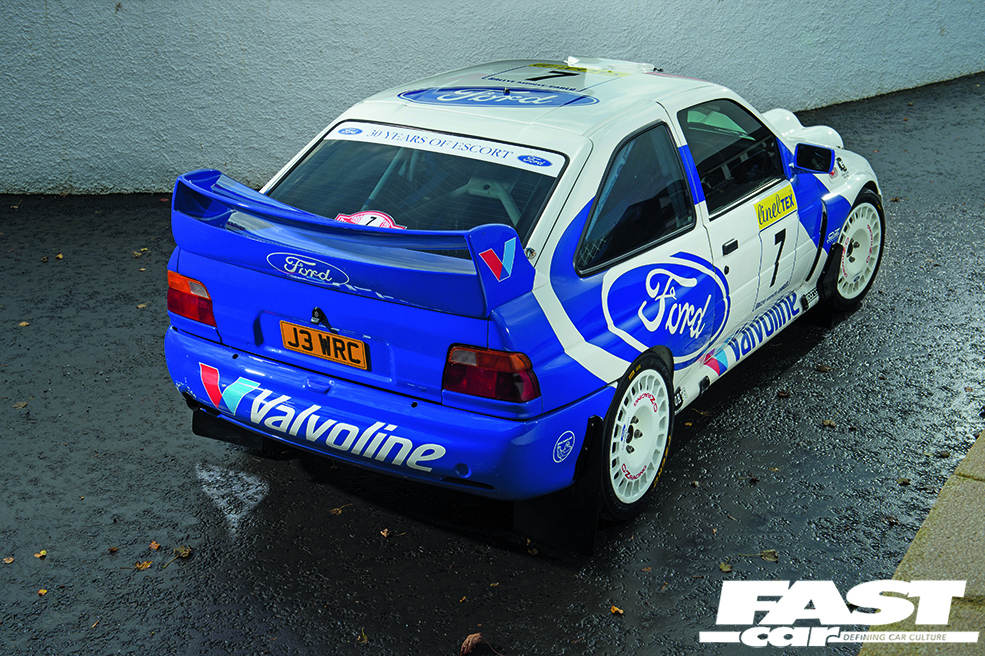
Of course, we don’t all get to be rally drivers. The celestial few are able to make a living out of it, a bunch of enthusiasts try their hand in an amateur capacity, but for most of us this is all just the stuff of unattainable dreams. Which makes us all the more envious of Tom Blackwood, who’s been fortunate enough to add this genuine WRC-spec Escort to his already stellar collection of rally machines. “I’ve always owned nice cars, but only got into owning rally and modified cars in the last few years,” he explains. “I’ve always liked Ford motorsport cars, and I found it easier to concentrate on one marque! I actually first saw this Escort WRC at an event in Ireland, and I was blown away by the sound and performance of it; I asked the owner if he would consider selling it, but he wasn’t keen on selling up. Nevertheless I left contact details with him, and about a year later he called me and a deal was done!” You can imagine Tom’s excitement when that call came through. After all, just fifty WRC-spec Escorts were built between 1997-98, they’re not exactly commonplace on the used car market.
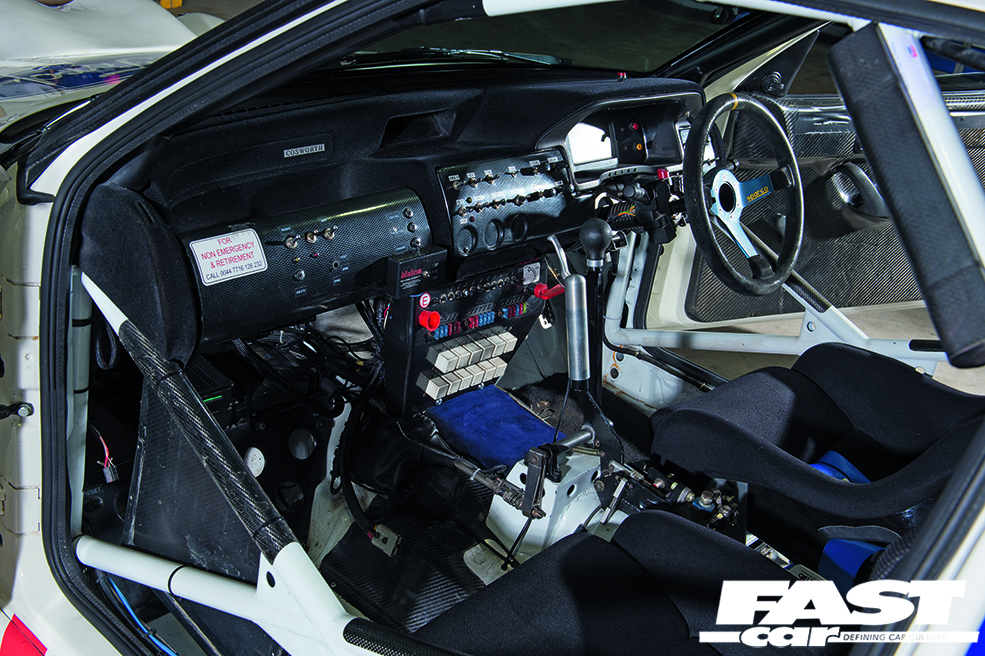
The fact that the car exists at all is, in fact, something of a marvel. With the mists of ages clouding the history of the Escort RS Cosworth for the twenty-first century enthusiast, it’s easy to forget that the model was first and foremost a motorsport machine rather than a ludicrous road-going hot hatch. Homologation has become a trendy buzzword for marketing departments to flog special editions, but back in the nineties this stuff was serious: the road-going EsCos only came into existence because Ford wanted to go rallying, and the Group A regs demanded a certain number of models sitting on the forecourts with number plates and tax discs. The sight of a longitudinal engine under that extravagantly vented bonnet still has the power to surprise the uninitiated on the showground – it’ll come as no surprise to you that the car was basically a redeveloped Sierra with a bunch of Escort panels draped over it – although it’s interesting to note just how different the road car actually was to the rally car. Consider the changes, it’s a long list: the chassis was seam-welded and a rollcage welded in, a larger intercooler was fitted with water injection and external water spray, the suspension was redesigned to allow all settings to be adjusted on the fly – with shock absorbers being liquid-cooled, the brakes were swapped to whopping 8-pot Brembos at the front and 4-pots out back, a six-speed sequential gearbox was fitted with dual-plate carbon dry clutches, and the fuel tank was relocated inside the car. As for the engine, that was treated to a lightened and balanced forged crank, bespoke cams, forged pistons, and the head was extensively polished and ported to allow for some pretty massive valvegear. The lubrication system is of a far larger capacity and features a magnesium sump, while the fuelling system sports twin high-pressure pumps. All of this led to an even 300bhp, delivered with ferocious urgency. And the transmission? Yes, that was something special – we’re looking at three self-locking differentials, with front and centre being managed electronically; this can be overridden by the driver, who has manual control to juggle torque between front and rear axles. And that was just the original Group A spec; the WRC cars had 330bhp, multi-link rear suspension, and fully reworked aerodynamics.
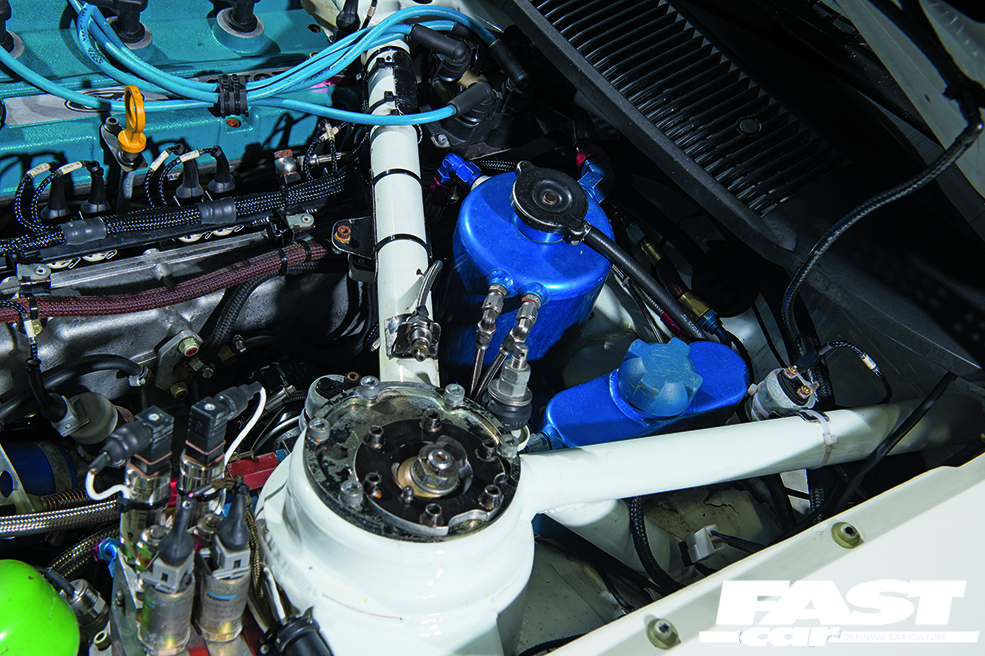
WRC Escorts were, it goes without saying, phenomenally serious bits of kit. Whereas today’s marketing sensibilities may see a fairly even split between highly-engineered, special-edition cars going into competition versus ending up pampered in private collections, it was all-in for the Cossies – every single one has a history of bouncing through forests and tearing up tarmac stages with vigorous energy. Combing through the history of J3 WRC, we find evidence of this car competing in Belgium and Ireland back in 1999 with Gary Midwinter behind the wheel, Melvyn Evans campaigning it through 2001 and ’02, David Armstrong taking the reins at Mayo in 2003, wringing its neck through to ’05, and a whole host of drivers ragging the proverbial nuts off it all across Europe through to 2015. When our man Tom was finally able to sign his name on the registration document. He wasn’t just buying an angry car with a fat lamp pod on the nose – he was acquiring a thick slice of rallying heritage.
“The car was well used cosmetically, but mechanically it was perfect,” he confirms with a smile. “So straight away we removed the vinyl wrap, got it painted, and the fresh livery was applied. It was sprayed by my company’s painter, after we’d replaced various fibreglass panels with proper, original steel ones. We replaced the Perspex windows with glass too, just to give it a bit of a sharper look!”
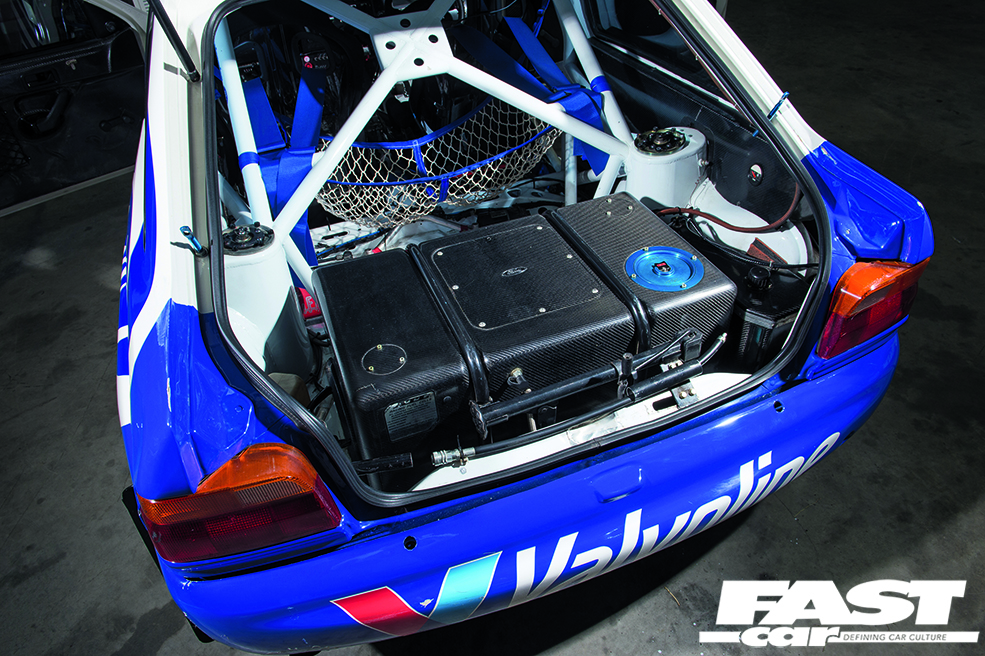
Sharp is a handy adjective to describe this car – it looks vicious and brutal from every angle, from the pumped-up arches stretched over that wider track to the artfully scarred rear bumper corners and the glutinous gobs of spent rubber inside the wheel-wells. The damn thing’s downright frightening. It’s evidently no show-pony – that extensive history demands continuous, sustained abuse.
“We take car to various rally demonstration days,” says Tom, “and just recently we used it in a two-day tarmac rally in which we finished 11th overall. Ideally I’d like to give it a full bare-shell rebuild and return it to as-new condition.” Well yes, that may be the ambition, but the car might have other ideas. With so many years spent roaring at trees and spitting flames at fence-posts, this outrageous Escort presumably feels that its time is better spent at maximum revs and more than a little sideways. And who could blame it? This car is all heart, all aggression, an assault on the senses and – above all – a thoroughly emotional experience.
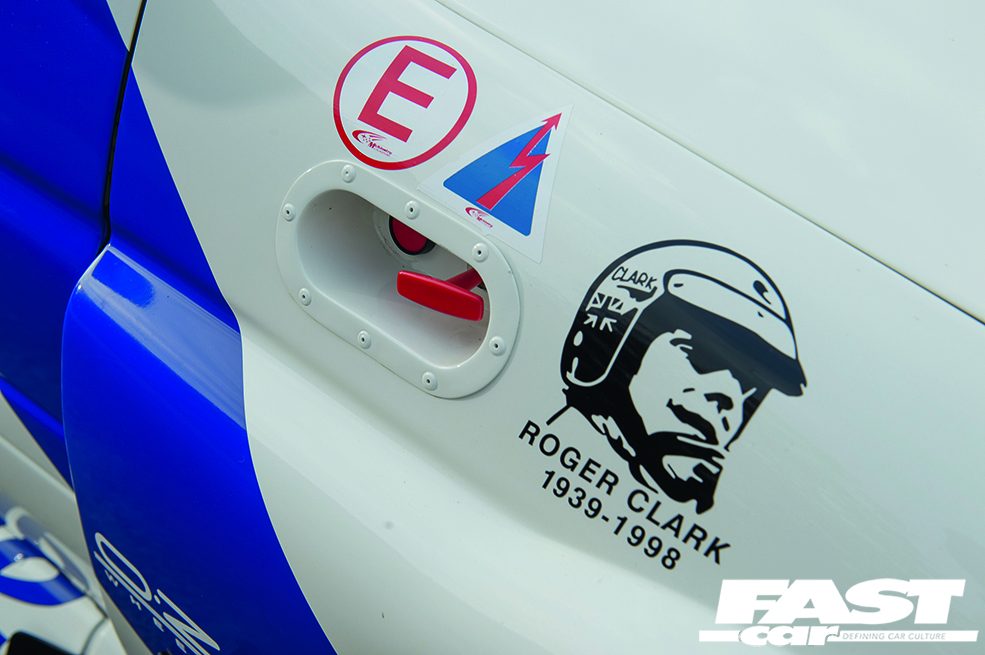
Tech Spec: WRC Ford Escort Cosworth
Engine
WRC-spec 2.0-litre Cosworth YB, anti-lag, carbon fibre air box, fuel cell in boot, Xtrac 6-speed sequential, 330bhp.
Chassis
8×18-inch OZ Racing wheels, 225×18 Pirellis, Reiger WRC-spec suspension, Brembo 8-pots (front) and 4-pots (rear).
Interior
WRC-spec inc. Recaro seats, Tilton harnesses, Sparco steering wheel, motorsport dash, carbon fibre doorcards, FIA rollcage with helmet nets, Lifeline system.
Exterior
WRC-spec, Valvoline livery, quad lamp pod.
Feature taken from Retro Cars magazine. Words: Dan Bevis. Photos: Ade Brannan.

